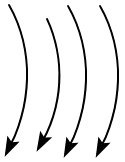(Take \(g=10~\text{ms}^{-2}\))
1. \(2\times10^3~\text{kg}\)
2. \(3\times10^4~\text{kg}\)
3. \(5\times10^4~\text{kg}\)
4. \(7\times10^4~\text{kg}\)
A liquid is poured into three vessels of the same base area and equal heights as shown in the figure, then:

| 1. | The maximum force on the base will be for the vessel \(C.\) |
| 2. | The maximum force on the base will be for the vessel \(B.\) |
| 3. | The maximum force on the base will be for the vessel \(A.\) |
| 4. | Force on the base will be equal for all the vessels. |
The area of cross-section of the wider tube shown in the figure is \(800~\text{cm}^2.\) If a mass of \(12~\text{kg}\) is placed on the massless piston, then the difference in heights \(h\) of the levels of water in the two tubes will be:

| 1. | \(10~\text{cm}\) | 2. | \(6~\text{cm}\) |
| 3. | \(15~\text{cm}\) | 4. | \(2~\text{cm}\) |
The value of g at a place decreases by 2%. Then, the barometric height of mercury:
| 1. | increases by 2%. | 2. | decreases by 2%. |
| 3. | remains unchanged. | 4. | sometimes increases and sometimes decreases. |
The height of a mercury barometer is \(75 ~\text{cm}\) at sea level and \(50 ~\text{cm}\) at the top of a hill. The ratio of the density of mercury to that of air is \(10^4.\) The height of the hill is:
| 1. | \(250 ~\text m\) | 2. | \(2.5 ~\text {km}\) |
| 3. | \(1.25 ~\text {km}\) | 4. | \(750 ~\text m\) |
A vertical \(\mathrm{U}\)-tube of uniform inner cross-section contains mercury in both its arms. A glycerin (density\(=1.3\) g/cm3) column of length \(10\) cm is introduced into one of its arms. Oil of density \(0.8\) g/cm3 is poured into the other arm until the upper surfaces of the oil and glycerin are at the same horizontal level. The length of the oil column is:
(density of mercury \(=13.6\) g/cm3)
1. \(10.4\) cm
2. \(8.2\) cm
3. \(7.2\) cm
4. \(9.6\) cm
A barometer kept in a stationary elevator reads \(76 ~\text{cm}.\) If the elevator starts accelerating up, the reading will be:
1. zero
2. equal to \(76 ~\text{cm}\)
3. more than \(76 ~\text{cm}\)
4. less than \(76 ~\text{cm}\)
| 1. | \(P_P=P_Q=P_R=P_S\) | 2. | \(P_P>P_Q>P_R>P_S\) |
| 3. | \(P_P<P_Q<P_R<P_S\) | 4. | The data is insufficient to predict the relation |
Which of the following diagrams does not represent a streamline flow?
| 1. |  |
2. |  |
| 3. |  |
4. |  |
Three liquids of densities \(d,\) \(2d\) and \(3d\) are mixed in equal proportions of weights. The relative density of the mixture is:
| 1. | \(11d \over 7\) | 2. | \(18d \over 11\) |
| 3. | \(13d \over 9\) | 4. | \(23d \over 18\) |







